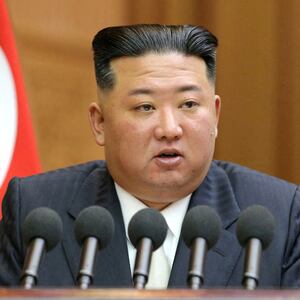North Korea says it will soon have its own spies in the skies capable of seeing what its enemies are doing, just as the U.S. has been spying on the North for decades.
Pyongyang’s Korean Central News Agency made that claim this week, reporting that the North has tested its first spy satellite and will have one of them up for real by April. The KCNA report was the latest word on North Korean progress in developing missiles and nuclear warheads as “defense” against its enemies, the U.S., Japan and South Korea.
Kim Yo Jong, younger sister of North Korea’s leader Kim Jong Un, scoffed at claims that the cameras weren’t as good as advertised by the North Koreans. On Tuesday, Pyongyang’s Korean Central News Agency quoted her as saying “so-called experts were so keen on finding fault with others that they could not but make such senseless words.”
ADVERTISEMENT
Such talk was “nonsense,” said Yo Jong, while North Korea hinted it might launch a missile strike against Japan in response to Japan’s policy shift calling for counter-strikes against its enemies. The North threatened actual action to show “how much we are concerned and displeased” with “Japan's move to realize unjust and excessive ambition.”
The U.S. and South Korea have also gotten involved with a move that was sure to evoke a torrent of rhetoric from the North. In the biggest show of force in the skies over and around South Korea, U.S. F22 Stealth bombers and B52s joined South Korean F35’s and F15’s in what the American and South Korean commands said were preplanned exercises.
Last week, the North, under the watchful gaze of leader Kim Jong Un, tested what it called a “high-thrust solid-fuel motor” designed to get missiles out of hiding and onto the launch pad before enemy satellites see them. Also, the souped-up motor should ensure that missiles, with or without nukes, are easier to steer to their targets.
The liquid-fueled motors that now power North Korean missiles into space are slow to move from their caves or tunnels and therefore much easier to spot from high above. Also, who knows precisely where the hell they'll land and explode
The North revealed its rapid advance as a military threat to the region days after Japan said it was doubling its military budget to $320 billion in five years as needed for defense against both North Korea and China.
Japan still isn’t talking about developing nuclear warheads, but it’s definitely breaking the constraint against spending more than one percent of its $5 trillion annual GNP on its euphemistically named “Self-Defense Forces” and possibly shedding the famous Article 9 of its post-war “Peace Constitution.” Dictated in the American military occupation under General Douglas MacArthur, Article 9 bans the Japanese from sending troops overseas or waging war at all.
Adding urgency to the North’s need for its own spy satellites, Japan’s Prime Minister Fumio Kishida said Japan should be able to fire its own missiles in self-defense. Presumably a North Korean spy satellite, if perfected by engineers and physicists who’ve managed to launch a number of other satellites over years, would let folks on the ground know what the Japanese were doing.
The North embellished its announcement with images of Seoul purportedly shot from the satellite, as if to show the South Koreans they had them in their sights. Or, as Hong Min at the Korean Institute for National Unification, told the South’s Yonhap News, “to be making mockery to show that they can spy on us.”
North Korea’s Korean Central News Agency reported in detail on the test of the satellite, which apparently was launched by one of two intermediate-range missiles fired by the North on Sunday. They traveled about 340 miles, landing far off the North’s east coast.
The reason for the test, said KCNA, was to evaluate “the satellite photography and data transmission system and ground control system” of the satellite. The test, it said, was “an important success which has gone through the final gateway process for the launch of a reconnaissance satellite.”
North Korean masterminds, however, still have a way to go in perfecting a satellite with the capabilities of American satellites.
Hong Kong’s South China Morning Post quoted Lie Il-wook with the Korea Defense Network as deriding the test as “too crude to be used for any purpose.” He noted the KCNA report said the satellite could see images on the ground of about 20 meters in size while U.S. satellites can make out the numbers of the license plates of motor vehicles.
North Korea’s National Aerospace Development Administration was undeterred by such details.
In an exercise in mumbo-jumbo, the report in English said the test “was conducted in the mode of evaluating the processing capability and stability of data transmission devices while verifying the reliability of the ground control system including photography control command and attitude control command for various kinds of cameras in the optimum environment simulating space environment after the high-angle launch of a test-piece satellite up to the altitude of 500km.”
The KCNA report acknowledged, however, that “one panchromatic camera” aboard the test vehicle had only 20 meters resolution and omitted the range of two more “multispectral cameras, video transmitter and transmitters and receivers of several bands, control devices and batteries.”
No problem. The test, it said, had “confirmed the important technical indices including the technology of camera operation in space environment, data processing and transmission capability of communication devices and the tracking and controlling accuracy of the ground control system.”
The U.S. has claimed North Korea earlier launched satellites to test their systems for long-range missiles, which the North has test-fired twice in recent months.
Ankit Panda of the Carnegie Endowment seemed inclined to give the North due credit for developing the spy satellite. NK News, a South Korean website monitoring North Korea, quoted him as saying the test showed an “optical satellite payload with pictures of Seoul from :a significant altitude outside the earth’s atmosphere.”
Officially, South Korea condemned the “provocation” of launching missiles, with or without satellites, which spokesman Cho Joong-hoon said was in violation of United Nations sanctions. Yonhap quoted him as saying “North Korean authorities need to make efforts to develop their economy and improve North Korean people's human rights and the quality of life.”
North Korea, shrugging off the tut-tutting, was euphoric about the test of the solid-fuel engine. In a comment that covered pretty much all its advances over the past year, KCNA boasted, “This important test has provided a sure sci-tech guarantee for the development of another new-type strategic weapon system.”







